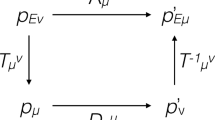Abstract
We find the relation between the frequencies received by two observers placed at a given parallel with 180° difference in longitude when they observe a distant light (radio) source. This relation depends on the absolute velocity of the Earth; however, because of the occurrence of aberration, the effect cannot be registered in practice.
Similar content being viewed by others
References
D. Hoff,Sky and Telescope 43, 9 (1972).
S. Marinov, inAbstracts of the 8th International Conference on General Relativity and Gravitation, Canada, 1977, p. 244.
S. Marinov,Found. Phys. 8, 637 (1978).
S. Marinov, The quasi-Römer and quasi-Bradley experiments according to absolute space-time theory, to appear.
H. Poincaré,Bulletin des Sciences Mathematiques 28, 32 (1904).
D. S. Robertson,Nature 257, 467 (1975).
Author information
Authors and Affiliations
Rights and permissions
About this article
Cite this article
Marinov, S. The quasi-Doppler experiment according to absolute space-time theory. Found Phys 11, 115–120 (1981). https://doi.org/10.1007/BF00715199
Received:
Issue Date:
DOI: https://doi.org/10.1007/BF00715199




